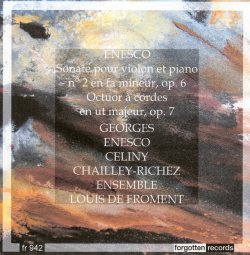|

|
Georges ENESCO (1881-1955)
Sonata No. 2 for violin and Piano in F minor, Op. 6 [22:03]
Octet for strings, Op. 7 [39:01]
Georges Enesco (violin)
Celiny Chailley-Richez (piano)
Ensemble Louis de Froment (Robert Gendre, Marie-Louise Ricros, Frederic Geyre, Denyse Marchand (violins). Marie-Therese Chailley, Colette Lequien (violas), Andre Remond, Jean Brizard (cellos))
rec. May 1951, Paris
FORGOTTEN RECORDS FR 942 [61:05]
Listening to Enesco the violinist, I hear certain qualities in his playing that bring to mind those of his most illustrious pupil Yehudi Menuhin. I don’t hear them in other violinists who came under his influence. One characteristic is fervent expressiveness and another is the inimitable way he shapes a phrase. Another feature that Menuhin and Enesco share is the ability to bring spontaneity to music, as though it is being created on the wing. There’s an improvisatory element always present. Enesco makes the music live, and his sound, like Menuhin’s, has a life to it. There is no doubting that the pupil was greatly influenced by the master’s style.
The Second Violin Sonata Op.6 was composed in 1899 whilst Enesco was still a student at the Paris Conservatory. It is dedicated to Jacques Thibaud who premiered it with the composer at the piano the following year. Tinged with influences of Brahms and Fauré, his composition teacher, it also embodies Romanian folk elements, fusing these with aspects of classical sonata-form. With this sonata, Enesco abandoned the foursquare classical template of the First Sonata and, for the first time in his composing career, found his own individual voice.
Enesco recorded the sonata twice. The first time was in 1943 in Bucharest for the Romanian label Electrecord. His pianist on that occasion was his fellow Romanian Dinu Lipatti. Then in 1951 he re-recorded it for Remington with Celiny Chailley-Richez. Listening to the two recordings side by side, the later recording is in much improved sound. Interpretively the performances are not very different, and each pianist responds well to the violinist’s imaginative phrasing. In the third movement ‘Vif’ I did feel, however, that Lipatti invests it with more rhythmic energy than his French counterpart. All of Enesco’s qualities as a fiddle player are evident, an amalgam of Romanian gipsy, Viennese charm and French culture.
The Octet Op. 7 was composed directly after the Second Violin Sonata. He was nineteen at the time, and the work’s composition strikes a direct comparison with Mendelssohn’s opus in the same genre. He was sixteen. It is amazing how youthful genius has brought out the best in two very different composers. Enesco’s is a big-boned forty-five minute work in four movements, the last two being linked. Richly textured with dense scoring it is a very accomplished work in which the composer displays his skills in counterpoint and a mastery of sonata-form.
Whilst the Ensemble Louis de Froment give a compelling performance of this exacting chamber work, many allowances need to be made by the listener. Remington pressings were known for their surface noise, but this isn’t so much an issue as the lack of clarity and definition between the various instruments in the densely-packed score. Enesco directs the players, and there is a freshness and spontaneity in the performance, with the players responding well to his inspirational leadership.
Remington and Varese LPs have been used in the digital re-mastering. There are no booklet notes, but information on relevant websites is given. I am grateful to Forgotten Records for making these valuable recordings available.
Stephen Greenbank
 |
 |
|
